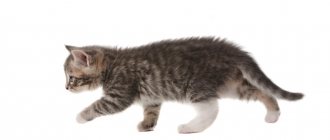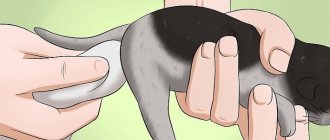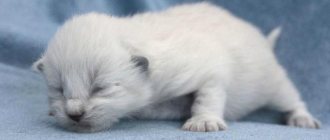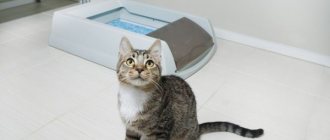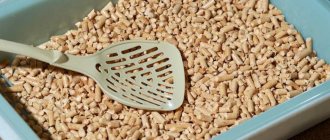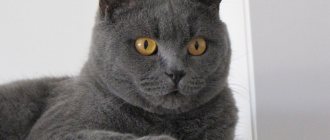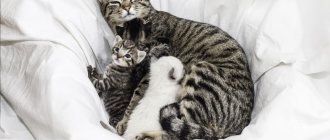The quantity, quality and frequency of urine excreted is the most important indicator of the health of a cat. It’s good when owners control their pet’s trips to the litter box. This will allow you to promptly detect that there is something wrong with the animal’s urinary system.
We will look at how many times a day a cat should pee, we will name the symptoms and possible causes of deviations from the norm, methods for identifying and eliminating pathologies, and we will also tell you how to prevent problems associated with impaired urination.
Features of the urinary system of cats and cats
There is nothing special in the structure of the kidneys, ureters and bladder of these animals, with one exception. The kidneys of cats are supported by very long ligaments, so they constantly change their position, like the wandering kidney in humans. This is a pathology only for humans, and mobile cat kidneys do an excellent job of producing and filtering urine.
Another thing is the urethra (urethra). In cats, this hollow tubular organ is quite short and wide. Its diameter allows you to painlessly remove sand and small stones, preventing blockage of the urinary tract.
The male urethra is long and thin, and along its length there are numerous narrowings (stenoses). In addition, it has an S-shape, which makes urination even more difficult.
Normally, the body of pets of both sexes excretes from 50 to 200 ml of urine per day, this depends on the size and weight of the animal. Now we’ll find out how many times a day a cat should pee.
Help for newborns
If the newborn baby in your care cannot recover on his own, you must help him. There is nothing complicated in this procedure. Don’t forget that experienced cat mothers, despite the lack of video lessons and courses on caring for newborns, successfully cope with this responsibility. Moreover, everything should work out for you! The main thing is to calm down and follow the instructions exactly.
Stock up on damp cotton wool, a napkin or a soft, clean cloth, or better yet, several. Place them on the table in front of you on the side of your dominant hand so that you can quickly replace the dirty one with a fresh one. You will need them to stimulate the anus, just like mother cats do.
Cover the table on which you will perform the procedure with old film or other hygroscopic fabric that absorbs liquid well.
We suggest you familiarize yourself with: Reproduction of black mollies and caring for fish in an aquarium || How long does mollies pregnancy last?
Sit in a comfortable chair so you have support for your arms. Take the kitten in your left hand (if you are right-handed), with the tail facing you. Be very careful! Don't squeeze your baby too tightly. At the same time, try to hold it so that it does not slip out of your hands and get hurt.
Begin to carefully, in a circular motion, massage the anal and genitourinary openings with a piece of slightly damp cotton wool. This will help stimulate the excretory reflex. Replace used materials with fresh ones as necessary.
At the end of the procedure, all that remains is to return the baby to the basket, throw all used materials in the trash and wash your hands thoroughly.
You need to do this massage every day, for a minute or two. You are doing everything right if your ward was able to poop or at least pee during this time. If neither one nor the other happens, you need to show the baby to the veterinarian.
Why do cats pee more often?
When a cat goes to the toilet only twice a day, this is normal. If the animal is healthy and the cat is not overfed, the bladder is completely emptied and refills within 12 hours. If a cat is “walking” or carrying offspring, it may go to relieve itself more often, but this is a temporary phenomenon.
Sterilization has no effect on how many times a day a cat pees. At the end of the recovery period, urination is normalized to 1-3 times a day.
The long, tortuous urethra does not allow cats to completely empty themselves in one go. Neutered pets and stud cats visit the litter box at least 3-4 times a day. But the latter also mark their territory, which is not regarded as a full-fledged act of urination. Also, some owners note that after castration their cats begin to pee more often. This is also considered the norm.
However, there are exceptions to every rule, and there are cats that rarely relieve themselves throughout their lives and feel great. Therefore, when wondering how many times a day a cat should pee, it is important to take into account the individual characteristics of the animal and the conditions under which it is kept.
What to do if the kitten does not go to the toilet in a big way?
Are you unable to take your pet to the doctor? No problem. An enema with lukewarm water and a small amount of Vaseline oil will help him recover successfully. Depending on how many days or weeks your mustachioed patient is, its volume can reach 1-5 milliliters.
As a syringe, you can use a five-cc syringe without a needle. Fill it with the required amount of liquid, lubricate the cone with Vaseline and gently but firmly, with some pressure, insert it into the kitten’s anus. After some time, your patient will poop easily and painlessly.
What affects the process of urination in cats?
Animals, like people, are all very different. Some cats have been lazy and lazy since childhood, while others jump around in closets until old age. Among the cats there are little-eaters and gluttons, water-drinkers and those who drink very little. From here a number of patterns can be traced in the process of urination:
- Cats that eat little and sleep most of the day can go to the litter box once during the day and once at night.
- Lazy cats can endure for a long time in order not to make unnecessary movements, so they accumulate urine and pee rarely and a lot.
- How many times a day a cat should pee is known to the owners of active and active animals. Their pets will not tolerate it, they go to the toilet as needed, and if they often touch a bowl of water, they can go to the litter box up to 6 times a day.
And if a cat goes to the toilet in this mode all his life, then this is normal. As animals age, the number of acts of urination may gradually decrease or, conversely, become more frequent. This is due to the natural aging of the body and inhibition of urination function.
If in a short period of time a cat begins to pee less often or more often, or the amount of urine excreted has noticeably decreased or increased, this may be one of the symptoms of a disease, not necessarily of the urinary system.
What if there are deviations?
Deviation from the norm in the number of visits to the tray requires mandatory consultation with a veterinarian. It is important to quickly determine the cause of the problem in order to prescribe treatment.
Be sure to read:
The cat cannot go to the toilet in a small way, what to do at home: first aid
A number of diseases can be successfully treated at the beginning of their development, but in an advanced form they can most likely lead to the death of the pet.
When to sound the alarm
Violation of the process of urination and its frequency after some time is accompanied by other signs of the development of pathological conditions. Therefore, it is important to pay attention to how many times a cat pees, the quality of its urine and the general condition of the animal. Owners should be alarmed by the following signs:
- cloudiness and change in the color of urine (instead of light yellow - orange, brown, the color of meat slop, or, conversely, colorless);
- a swollen or hard, tense abdomen, when stroking the cat reacts painfully or aggressively;
- the pet misses the tray and pees intensely;
- strong thirst appeared for no apparent reason;
- the appetite disappeared, the cat became lethargic or, conversely, restless.
The first sign of the development of many pathologies in cats is just a change in the quantity and quality of fluid secreted, which is why it is so important to monitor how many times a day a cat pees. Felines are one of the hardiest animals, and deterioration in their general condition often manifests itself only against the background of chronic processes.
How can you tell if your kitten is constipated?
Problems with bowel movements occur quite often in small kittens, especially in cases where the babies are left without a mother and are bottle-fed. You can tell if your kitten is having difficulty defecating by the following signs:
- frequent, but, in most cases, unsuccessful attempts to go to the toilet;
- hard, dry excrement;
- fear of another attempt to defecate, plaintive meowing caused by pain;
- impurities of mucus or blood in the stool;
- loss of appetite;
- weight loss.
Causes of urinary dysfunction
A pet’s illness is a difficult ordeal for both it and its owners, but many problems with the animal’s health can be avoided. Let's consider the most common causes of the development of pathologies and their consequences:
- Overfeeding and obesity often lead to the development of diabetes. In this case, one of the clinical manifestations is frequent, copious painless urination, and sometimes urinary incontinence.
- An unbalanced diet, cheap food, fish in the diet, poor quality water, and a sedentary lifestyle provoke urolithiasis. Urination becomes frequent, painful, mixed with blood, or there may be a complete absence of urine while the urge persists.
- Hypothermia, stress, stagnation of urine, stones, and ureteral infections cause the development of cystitis. The first sign of bladder inflammation is very frequent, almost futile trips to the toilet.
- Vitamin B6 deficiency, helminthic infestations, and disturbances in the outflow of bile can cause cirrhosis of the liver. A striking clinical manifestation will be the orange color of urine excreted in large portions, often past the tray.
If you do not constantly monitor how many times a day your cat pees, it is easy to miss the manifestations of inflammatory kidney diseases, for example, pyelonephritis or glomerulonephritis. By the age of 8, the chronic form of the pathology turns into renal failure. The cat begins to drink a lot, go to the toilet up to 10 times a day, the urine becomes colorless and odorless.
Cats are not only very hardy, but also extremely patient, and a pet screaming in pain is actually an extremely rare occurrence. This often misleads owners and gives the false impression that everything is fine with the animal. Therefore, changes in the nature of urination should be an important reason for owners to show the cat to a specialist.
Elderly cats
Elderly individuals are less mobile, consume less food, which can cause digestive disorders. As a result, the norm is considered to be the appearance of feces in the tray once every two days.
The stool may have a soft or hard consistency. Their color is possible both light and dark. If an older pet feels fine and does not constantly scream due to pain or when going to the toilet, then there is no need to consult a veterinarian.
Be sure to read:
Antigadin for cats: purchased and homemade products
Diagnostics
An experienced veterinarian can make a preliminary diagnosis simply by examining the pet and talking with the owners. He will definitely ask how often the cat pees. However, in most cases, one or more diagnostic measures are required:
- urinalysis is an important study that allows you to detect changes in the pH and density of urine, sand, salts, protein, glucose;
- biochemical blood test is a highly informative diagnostic method that determines the condition of internal organs and systems;
- Ultrasound of the abdominal organs is now practiced in most veterinary clinics for the timely detection of infectious, inflammatory and tumor diseases.
Based on the diagnostic results, the doctor prescribes treatment. It is necessary to fight for the animal, especially since modern veterinary medicine has all the necessary means for treatment.
Safe deviations from the norm
Stress can disrupt a cat's routine.
The animal may occasionally experience deviations from the norm when urinating. The pet can walk small once every 1-2 days. The reason may be:
- stress;
- climate change;
- change of feed;
- carrying out sterilization or castration.
As for sterilization and castration, it takes up to 2-3 days for cats to restore function. Neutered cats take longer days because they undergo deep surgery. The first days after the procedure, they go to the toilet through a catheter.
Pathological deviations from the norm
The genitourinary system of a cat.
If your cat has not gone to the toilet for more than 2 days
, or urination is difficult, comes in scanty doses, then the animal should be examined.
Inflammatory processes in the body can be accompanied by the following symptoms:
- lack of urination;
- difficulty urinating with scanty discharge;
- it is painful for the animal to go to the toilet, which is expressed by frequent meowing;
- the presence of various impurities in the urine (blood, mucus, sand);
- apathy, bad mood;
- lack of appetite;
- elevated temperature;
- general poor health (hot tips of the ears, pale and unhealthy-looking gums);
- swelling in the abdominal area.
Video about acute urinary retention in a cat
Urolithiasis
Symptoms of urolithiasis.
They often occur due to hypothermia, as well as poor nutrition, cheap feed, and poor animal hygiene. They affect cats more, both regular and neutered, due to the specific structure of the genitourinary system.
If the animal has no desire to go to the toilet for more than two days, the pet does not feel well, its stomach is swollen, or there are any impurities in the urine, then contact your veterinarian immediately
. If the disease progresses, surgery may be required.
Prevention of urolithiasis and diseases associated with the kidneys and genitourinary system
Don't forget to change the water in your cat's bowl.
To protect your pet from urinary problems, owners should:
- feed your cat or cat in a balanced manner (2-3 times a day);
- give clean water;
- include in the diet not only dry food, but also canned food, boiled chicken, meat, fish (no more than once a week), dairy products, cereals;
- wash the tray thoroughly;
- keep the house clean;
- do not allow the animal to become hypothermic;
- notice changes in your pet’s behavior in time and contact a veterinarian.
The health of cats depends primarily on their diet. As a rule, kidney and bladder diseases often occur in overweight cats.
In addition, food also influences the occurrence of pathologies. It is not recommended to give dry food frequently. Veterinarians advise. If your pet already suffers from urolithiasis, then it is necessary to include appropriate food in its diet.
The mother cat closely monitors the toilet of a newborn kitten, carefully licking it and keeping it clean. With the arrival of a small kitten in the house, the responsibility for monitoring the proper functioning of its digestive system falls on the owner.
Their future health depends on how often kittens go to. To help the pet develop healthy, it is useful for the owner to know why bowel problems occur, how many times month-old kittens should go to the toilet, and what to do if the kitten does not go to the toilet for a long time.
Toilet for newborn kittens
A mother cat helps a newborn kitten go to the toilet in the first three weeks of its life. A cat, licking its cubs, not only cleanses them of dirt and foreign odors, but also stimulates blood circulation in the digestive organs.
Thanks to this massage, it is easier for the kitten to get rid of gases and empty itself. The cat licks off all the dirt, leaving the appearance that the kitten does not go to the toilet at all.
If for some reason the cat does not know how to provide proper care to the kitten, you can help him yourself. In a situation where the kitten does not want to go to bed for several days, and in order to eliminate the consequences of a bloated abdomen from gases, certain actions need to be taken.
Using a soft brush or cotton wool moistened with warm water, gently massage the kitten's belly in a clockwise direction in a circular motion. Additionally, a soft massage is performed in the direction from head to tail, with longitudinal movements.
Toilet for one-month-old kittens
Upon reaching three weeks of age, the kitten’s intestines are already sufficiently populated with beneficial microflora, formed and ready to accept adult food. At this age, the kitten still eats mother's milk with gradual complementary feeding in the form of liquid food or creamy food. This food does not injure the intestines and does not require too thorough chewing.
At three weeks of age, a kitten should go to the toilet approximately 3 to 6 times daily. Normally, a kitten's feces should be mushy, uniform and thick. They should not contain impurities in the form of mucus or undigested food elements. The kitten itself should be cheerful, and its belly should be soft to the touch and painless. An unfavorable sign for the owner is kitten feces that are too dry or too runny.
If the kitten does not have stool for 3 or 4 days, you need to carefully analyze the pet’s diet. Abdominal massage, microenemas, and a small amount of vegetable oil can help.
Toilet for adult kittens
The kitten is transferred to adult food from the age of 1 to 3 months. In general, coca feces become more shaped. The number of visits to the toilet, as well as the consistency of feces, depend on the type of food the kitten eats. When eating food with a lot of fiber, the number of bowel movements will be greater than with high-protein food.
A grown kitten goes to the toilet almost every day, and its feces should be free of blood, mucus, and undigested food. The owner should be wary of the fact that the pet often goes to the toilet with very liquid feces.
Additional information on the topic of a kitten visiting the toilet can be found in the following video:
How often should a kitten pee?
When answering the question of how often a kitten should pee, you need to take into account the amount of liquid it consumes. The amount of urine should be equal to the volume of liquid drunk. A very small kitten has a small bladder capacity and will pee more frequently than an adult.
On average, a kitten goes to the toilet up to 10 times a day. An older kitten will have to go to the toilet up to 5 times a day. An adult cat goes small no more than 3-4 times a day.
The process of urination itself is normal and should not cause discomfort to the kitten. It is worth paying attention to the quality and color of urine, its transparency, the presence of impurities in the form of blood and mucus.
Signs that a kitten wants to go to the toilet:
- The kitten scratches the floor or objects with its paws.
- The kitten often sniffs objects around, as if looking for a suitable place. Cats often go to the toilet in quiet, secluded places, which the kitten will try to find in the house.
- The kitten marks time, sits down, squeaks.
- If a kitten is thinking about going to the toilet, its eyes become glassy. In such cases, you need to transfer it to the tray as quickly as possible.
Why does a kitten have problems with stool?
Stress has affected bowel function. A kitten may refuse to go to the toilet due to worries about moving to a new home, changing its owner, or being separated from its mother. To help the kitten get comfortable in a new place, you should protect it from noise, sudden movements, and games with children. The kitten itself must begin to play in the new territory, run, and go to the toilet. If the kitten does not defecate within 5 days, you should contact a veterinarian.
Due to poor nutrition, the functioning of the digestive system is disrupted. In a new home, the kitten must adhere to the diet of its old owners for some time, with a gradual addition of new food. When choosing ready-made food, you should pay attention to special diets for kittens.
If a kitten does not walk for more than 5 days, even having gotten used to a new place and food, then constipation may be the cause of problems with stool. By feeling your pet's abdomen, you can determine the presence of bloating, which usually accompanies constipation.
A sign of constipation is the painful process of defecation in your pet. Signs of constipation are also: sitting on the tray for a long time, plaintive meowing.
How to deal with constipation in a kitten yourself
If your pet feels well enough, you can try to cope with your kitten’s constipation yourself with the help of:
- Oils:
if the kitten does not go to the toilet for several days, you can give simple vegetable oil in an amount of no more than half a teaspoon per day. You can introduce it into the mouth using an ordinary syringe without a needle, slowly so that the kitten does not choke. Vaseline oil is also effective for constipation. It can be added at each feeding, 0.5 ml, in combination with a gentle therapeutic massage. - Soap:
you need to make a small peg of baby soap and insert it into the anus. Before administration, the soap should be moistened in warm water. It is more convenient to carry out this action while the pet is sleeping. After it, within a few hours, the kitten should successfully go to the toilet for the most part. - Medications:
You should consult your veterinarian about the appropriateness and correct use of medications. - Enema:
the enema procedure at home is carried out only in full confidence that it is harmless to the kitten. This procedure is relatively safe only if the cause of constipation is precisely inappropriate nutrition, and not intestinal obstruction or volvulus. There is a list of conditions for which an enema is strictly contraindicated: inflammatory processes in the intestines, bleeding, rectal prolapse, acute pathologies of the abdominal organs, inflammatory processes in the intestines.
Do-it-yourself enema of a kitten
To do an enema yourself, you will need a 10-milligram syringe, warm boiled water, Vaseline or oil. It is advisable to do the procedure with an assistant: one will hold the kitten, and the second will slowly insert a syringe pre-lubricated (with Vaseline or oil), deep enough so that the liquid is distributed as intended.
During the procedure, you need to slowly introduce water, gently palpating the pet's stomach to ensure that the intestines are sufficiently full. For a kitten, 50-100 ml of water is enough for the procedure.
General information about the kitten's toilet
A kitten can go to the toilet anywhere from 10 times a day (in the early stages) to 5 times a day as it grows. If the kitten goes to the toilet too infrequently (up to 4 times a day), or goes to the toilet too often, or has other warning signs (blood, mucus in the urine), the owner should immediately contact a veterinarian.
On average, one-month-old kittens poop on their own 3 to 6 times a day. A kitten in a new place often does not go to the toilet for up to 5 days. If, after adaptation to the new place, the situation does not change, measures need to be taken.
The answer to the question of how often to change the tray depends on the composition. In general, after each visit to the litter box by a kitten, there should be no traces or smell left in it, otherwise the kitten will try to find another secluded place to relieve itself.
Our beloved pets, like people, are susceptible to various urological ailments. If a cat begins to have problems with urination, then this is most likely a warning about the presence of a dangerous disease of the urinary system. The best step for the owner in such a situation is an immediate visit to the veterinary clinic. But you don’t have to let it come to this, knowing exactly what the animal’s urination should be like. So, let's arm ourselves with useful information.
Treatment
It is clear that in each case, therapy is prescribed individually, but we can consider the general principles of treating cats for the most common diseases:
- For urolithiasis, antibiotics and antispasmodics are prescribed, and a urinary catheter may be installed. When the urinary tract is blocked by stones, surgery is performed.
- To treat cystitis in cats, antibiotics and diuretics are used in the form of injections and droppers.
- In case of liver damage, the water balance in the body is first restored, then hepatoprotectors are prescribed.
- With diabetes, some cats remain insulin dependent for life, while the health of others is maintained by glucose-lowering medications.
Following the doctor's recommendations, many owners literally pull animals out of the dead. The veterinarian will tell you how many times a day a cat who has suffered a serious illness should pee, and will certainly prescribe a diet. And this is an important preventive measure to prevent the development of dangerous pathologies in cats.
How to avoid urinary problems
Every owner of a cat should be aware that if the animal once gets a similar illness, it will be quite difficult to get rid of it. In order for your pet to feel comfortable and lead a full life, it is necessary to take a number of preventive measures and periodically visit the veterinarian. You can prevent possible abnormalities when urinating by following some tips:
- The animal must be vaccinated on time to reduce the risk of developing infectious diseases in the body.
- The pet should not be overcooled.
- The water must be clean and fresh. In addition, the animal must have unlimited access to fluids.
- The diet must exclude prohibited foods and must be compiled according to the rules of nutrition for a cat.
- The animal should move a lot, which is facilitated by outdoor games (at least 30 minutes a day).
If problems with urination occur, the animal should be treated by a veterinarian. Prescribing medications on your own can aggravate your pet’s condition and put its life in danger.
Prevention
The incidence of urolithiasis in cats is five times higher than in cats. This disease is one of the most frequently diagnosed after helminthic infestations.
Proper metabolism prevents the formation of stones, so a balanced diet is the key to health, especially when it comes to castrated and sterilized cats. These are truisms, but owners, even when buying premium food, do not comply with the feeding standards indicated on each package, so they mix the finished product with natural food.
Lack of water is one of the reasons for the formation of urate stones, and since cats have a poorly developed sense of thirst, there is a good way to teach your pet to drink more. Place several different vessels with water in different places in the house, this invariably arouses interest in the animals and a desire to try.
Protect your cat from hypothermia. Don't let him sit on a freshly washed floor until it's dry, and don't let him sleep on the floor under an open window. And, of course, watch how often the cat pees. This is the most important marker in home diagnostics of a pet’s health condition.
Diarrhea in a cat, causes
Diarrhea in cats develops quite often. A one-time loose stool should not frighten the owner, since it is usually a failure that occurs due to minor reasons that do not require a visit to a specialist.
Diarrhea in cats develops quite often
Diarrhea for 2 days or more requires therapy.
There are several main causes of diarrhea in cats:
- Feed intolerance. The animal’s body may not accept the food offered, even when it is of high quality. Most often, the phenomenon is observed when giving low-grade ready-made feed and milk. The problem can be solved by adjusting the diet.
- Sudden change in diet. The cat's intestines and stomach must gradually adapt to the new diet. If it is changed abruptly, diarrhea will easily occur due to irritation of the mucous membrane.
- Worm infestation. The toxins released by worms lead to poisoning, causing loose stools.
- Metabolic disease. This affects most processes in the animal's body, including the number of bowel movements and the density of feces.
- Bowel disease. Diarrhea most often develops with infectious lesions, but may also indicate tumor neoplasms and various ulcerative pathologies. A blood test will be required for diagnosis.
We suggest you read: Keeping and feeding rabbits after birth
A veterinarian can determine the exact cause of diarrhea in a cat after an examination.

